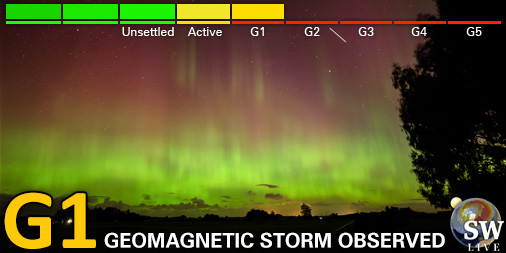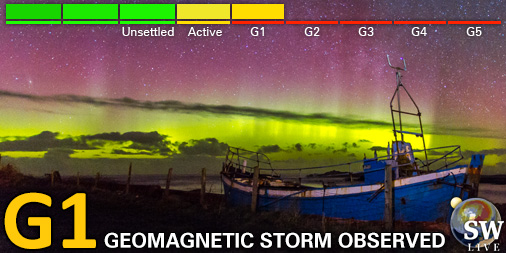Het archief bekijken van woensdag 18 juni 2003
Activiteitenrapport
Bij elke genoemde zonnevlam in dit rapport werd een schaalfactor toegepast door het Space Weather Prediction Center (SWPC). Vanwege de SWPC-schaalfactor worden zonnevlammen 42% kleiner gerapporteerd dan voor de wetenschappelijke data. De schaalfactor werd verwijderd uit onze gearchiveerde zonnevlamdata om de werkelijke fysieke eenheden weer te geven.
Rapport van de zonne- en geofysische activiteit van 2003 Jun 18 2200 UTCOpgemaakt door de NOAA © SWPC en verwerkt door Poollicht.be
USAF/NOAA rapport van de zonneactiviteit en geofysische activiteit
SDF Nummer 169 gepubliceerd omstreeks 2200Z op 18 Jun 2003IA. Analyse van de actieve zonneregio's en zonneactiviteit van 17-2100Z tot 18-2100Z
Solar activity increased to high levels today. Region
386 (S07E43) produced an M6.8 x-ray flare (correlated using SXI
imagery) at 17/2255Z that had an associated Tenflare (2100 sfu),
Type IV and Type II radio sweeps (an estimated shock velocity of 1000
km/sec). This region showed growth in the magnetic structure
surrounding the dominant lead spot as a delta complex has become
evident since yesterday. The penumbral field coverage has changed
little over the period. Newly numbered Region 387 (N18E62) produced
several minor flares during the interval.
IB. Voorspelling zonneactiviteit
Solar activity is expected to be at
moderate to high levels. Region 386 has the potential to produce an
isolated major flare.
IIA. Samenvatting geofysische activiteit 17-2100Z tot 18-2100Z
The geomagnetic field was at predominantly minor to major storm
levels with an isolated period of severe storm conditions seen at
high latitudes between 18/0600 and 0900Z. A co-rotating integrated
region preceding a recurrent high speed coronal hole stream and is
believed to responsible for the storm conditions. The greater than
10 Mev proton flux at geosynchronous orbit reached event threshold
at 18/2050Z and due to the recent activity the exact source for this
particle event is not certain.
IIB. Voorspelling geofysische activiteit
The geomagnetic field is
expected to be at predominantly active to minor storm levels due to
a recurrent high speed coronal hole stream. Isolated major storm
conditions are possible on day one due to the potential for
transient activity. The greater than 10 MeV proton event should
remain above threshold level through the first day of the interval.
III. Kans zonnevlammen van 19 Jun tot 21 Jun
| Klasse M | 60% | 60% | 60% |
| Klasse X | 20% | 20% | 20% |
| Proton | 99% | 50% | 25% |
| PCAF | in progress | ||
IV. Penticton 10.7 cm Flux
Geobserveerd 18 Jun 120 Voorspeld 19 Jun-21 Jun 120/120/120 90 dagen gemiddelde 18 Jun 125
V. Geomagnetische A index
Geobserveerd Afr/Ap 17 Jun 030/050 Geraamd Afr/Ap 18 Jun 035/050 Voorspeld Afr/Ap 19 Jun-21 Jun 025/035-020/025-020/025
VI. Kansen op geomagnetische activiteit van 19 Jun tot 21 Jun
| A. Gemiddelde breedtegraad | |||
|---|---|---|---|
| Actief | 40% | 50% | 50% |
| Kleine storm | 30% | 20% | 20% |
| Zware-ernstige stormcondities | 15% | 05% | 05% |
| B. Hoge breedtegraad | |||
|---|---|---|---|
| Actief | 40% | 50% | 50% |
| Kleine storm | 40% | 30% | 30% |
| Zware-ernstige stormcondities | 20% | 10% | 10% |
Alle tijden in UTC
<< Keer terug naar de dagelijkse overview pagina
Op basis van de huidige parameters is er nu geen kans op poollicht in België en Nederland
Laatste nieuws
Laatste forumberichten
Suggesties? 8Noorderlicht kans 6-1-2025 2Poollicht 1 januari 2025 2Naar Noorwegen in Maart? 3Noorderlicht kans 10/11-10-2024 56
Meer forumberichtenSteun Poollicht.be!
Om ook bereikbaar te blijven bij grote poollichtkansen hebben we een zware server nodig die alle bezoekers aankan. Doneer en steun dit project zodat we online blijven en je geen enkele poollichtkans mist!

Laatste alerts
15:09 UTC - Hemisferisch vermogen
Het OVATION-model voorspelt dat het hemisferisch vermogen 50GW zal bereiken om 15:48 UTC
08:00 UTC - Geomagnetische activiteit
G1 - Kleine geomagnetische storm (Kp5) Drempel bereikt: 07:52 UTC
zaterdag 3 mei 2025
10:45 UTC - Geomagnetische activiteit
G1 - Kleine geomagnetische storm (Kp5) Drempel bereikt: 10:30 UTC
08:57 UTC - Hemisferisch vermogen
Het OVATION-model voorspelt dat het hemisferisch vermogen 76GW zal bereiken om 09:32 UTC
01:00 UTC - Geomagnetische activiteit
G1 - Kleine geomagnetische storm (Kp5) Drempel bereikt: 00:55 UTC
Ruimteweer feitjes
| Laatste X-klasse uitbarsting | 28/03/2025 | X1.1 |
| Laatste M-klasse uitbarsting | 30/04/2025 | M2.03 |
| Laatste geomagnetische storm | 03/05/2025 | Kp5 (G1) |
| Zonnevlekkenloze dagen | |
|---|---|
| Laatste zonnevlekkenloze dag | 08/06/2022 |
| Maandelijks gemiddeld zonnevlekkengetal | |
|---|---|
| april 2025 | 140.6 +6.4 |
| mei 2025 | 58 -82.6 |
| Afgelopen 30 dagen | 114 -17.5 |





